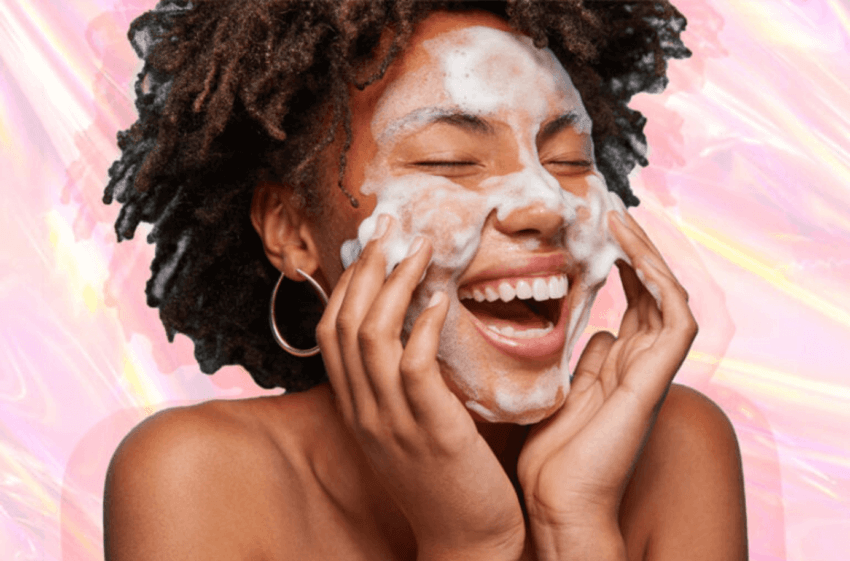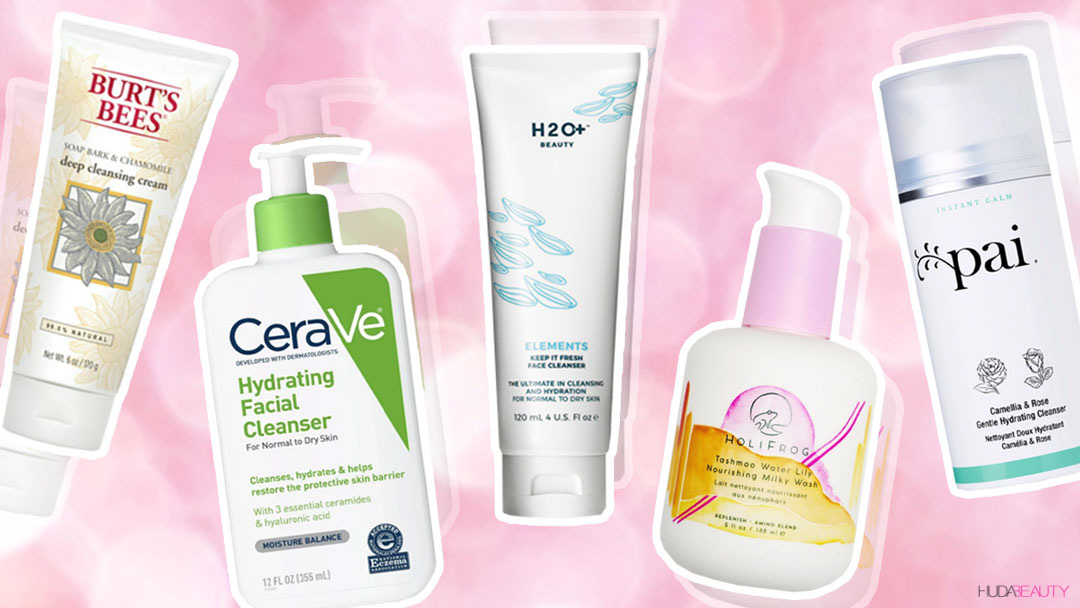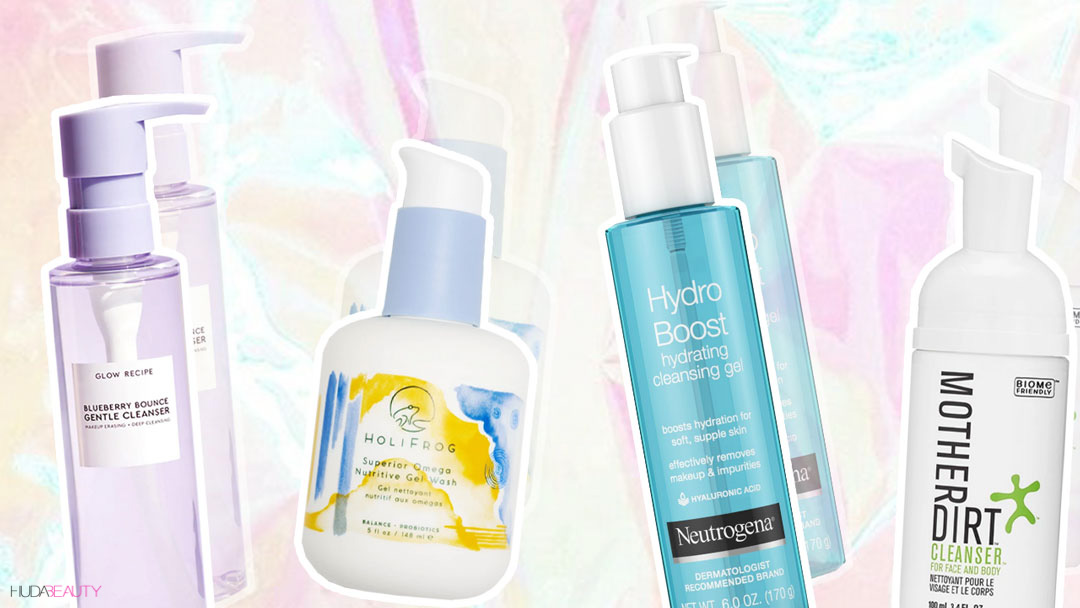Your Ultimate Guide To Cleansing + How To Pick The Best One For You

Cleansing is a fundamental part of any skincare routine, but it’s often not the most popular. There’s something about splashing your face and potentially stinging your eyes with suds that puts people off. Nevertheless, like eating your five-a-day, it’s an important daily ritual that’s essential for your skin.
But as with anything, there’s a proper way to do it. Choosing the right cleanser for your skin type and actually going through the process of cleansing properly (20 seconds is not enough!) is crucial. Even more importantly, listening to (or feeling) what your skin needs is number one, and that’s why we believe having more than one type of cleanser is essential.
Why One Cleanser Just Isn’t Enough
Emily Parr, Founder of new cleansing brand HoliFrog is passionate about skin and the important role the right cleanser plays: “During this brief and very important period [cleansing] is when the foundation of your skincare regimen begins, setting your skin up for the rest of what’s to come.” This is why Emily created what she calls a “washing wardrobe” with four key cleansers. She explains “Skin gets cranky, it gets thirsty, it has different needs at different times, so one-and-done is never going to cut it. I like to think of it as having a cleanser routine by situation, which we refer to as Situational Cleansing. What your skin needs when you wake-up is very different than what it needs after a workout or at night when you have makeup on and a day’s worth of grime on your face!”
Skin’s dry and tight? You need a hydrating gel, soothing cream or milky cleanser. Skin is oily or rough? A gel or foaming cleanser with AHAs or enzymes will be your best friend. Right now, you’re probably thinking this sounds boujee af and unnecessary, but in the long run, your skin will thank you for it. Harsh cleansers on dry skin will only dry it further and thick or mild cleansers on oily or acne-prone skin will only lead to clogged pores. You probably think that sounds doubly expensive, but it just means you always have two cleansers handy and they both last longer!
Posts You'll Love:
We’re also going to throw it out there, that in an ideal world you might even have three cleansers – hear us out! Ever since we started following the Korean double cleansing method, our skin has been so much better. This method involves cleansing first with an oil-based cleanser, then a water-based cleanser…
The Double Cleansing Ritual:
1. First, cleanse by massaging an oil or a balm (starting on a dry face), which will dissolve and melt SPF, makeup, and dirt. Oil attracts oil so it binds with sebum, grime and makeup most effectively – sometimes you can even feel sebum plugs being pushed out of your pores. Massage for at least one minute! We’re obsessed with the WISHFUL Clean Genie Cleansing Butter, $35, which is one of the most gentle but powerful cleansing balms we’ve ever used.
2. The second step is to use a cleanser that works for your skin type, and of course, how your skin feels that day (which is why it’s worth having two). If the weather’s getting cooler or you’ve used too much retinol and your skin is feeling drier, you may want to alternate evenings that you use an AHA (exfoliating) or foaming cleanser, with something gentle like a hydrating gel, milk or cream cleanser. Aim to wash your face for at least 60 seconds, that way the formula can penetrate pores before it’s washed away.
 via Giphy
via Giphy
How to Choose a Cleanser for Your Skin Type:
Gel Cleansers
BEST FOR: Normal/ Combination/ Oily/ Acne-Prone Skin
Gel formulas are clear with a thick gel consistency, and they’re amazing for deep cleansing. They decongest clogged pores, remove excess oils without stripping the skin.
Beware of: Strong ingredients that can overly strip your skin. If your face feels tight after using a gel cleanser, it could be too intense for your skin.
Cream Cleansers
BEST FOR: Dry/ Sensitive/ Aging Skin
Cream cleansers are typically a thick, dense formula that is extremely moisturizing (perfect for aging skin). The rich consistency means that they’re often less foaming, and as a result, shouldn’t dry your skin. Some formulas recommend applying on dry skin and wiping away with a cotton ball – in this case, it’s better to use a toner after to make sure no residue is left on your skin.
Beware of: Some cream cleansers can be very rich, so look out for labels that say non-comedogenic, which means it won’t block your pores.
Foam Cleansers
BEST FOR: Oily/ Acne-Prone Skin
Foaming cleansers usually come with a pump dispenser and they’re great for cleaning deep into pores. There’s a little controversy around foam cleansers, as some believe they can be too harsh on your skin, but foam cleansers are a great option for oily-prone skin types, just be sure to thoroughly hydrate your skin, post-cleansing, and consider using this just as part of your nighttime routine, instead of twice a day.
Beware of: Try to avoid sodium lauryl sulfate (a foaming agent), as this ingredient can irritate sensitive skin.
Milk Cleansers
BEST FOR: Dry/ Normal/ Sensitive/ Aging Skin
These extra-gentle milky formulas are an emulsion of fats and water – the tiny droplets of fat in the water give the formula its milk-like look and silky texture. Cleansing milk doesn’t foam, but instead, it dissolves dirt, makeup, and sebum, with oils and fats; this makes it extremely moisturizing as it won’t strip your skin with chemicals.
Beware of: If you wear heavy makeup or have just done a workout, you may want to use a more powerful cleanser first and then follow with your milk cleanser to ensure your thoroughly clean.
Oil Cleansers
BEST FOR: Makeup Removal/ Dry/ Sensitive Skin/ Eczema
The theory behind cleansing oils is that is oil attracts oil. So, when you massage an oil cleanser into your skin, those good oils bind with the sebum and any makeup oil and dirt, which are then rinsed away together. An oil cleanser is a very gentle way of removing dirt from your skin, and it doesn’t clog your pores because it doesn’t sink in, it only removes impurities. Cleansing oils will also balance and maintain your skin’s natural pH, preventing your skin from producing excess oil, like it might do to combat drying ingredients from other cleansers. We love to use a cleansing oil as the first step in our cleansing routine, and then follow with a water-based cleanser that suits our skin type.
Beware of: Parabens, petrolatum, phthalates, and sodium lauryl sulfate (SLS). If you have oily or acne-prone skin, look for thinner oil formulas or balms that transform into a milk before rinsing away. We love the Keihl’s Midnight Recovery Botanical Cleansing Oil, $32, which is a lightweight oil that’s non-comedogenic.
How to Build a Cleanser Wardrobe:
Our advice? Have three cleansers at all times. This way you can choose one that suits your skin’s needs. While it’s important to understand the best type of cleanser to suit your skin, if that cleanser is on the harsher end of the spectrum, it may be better to use it just once a day to avoid drying out your skin.
For morning: You only need to use something very gentle like a milk, cream or gel (or even a splash of water) because you’ve already thoroughly cleaned your skin the night before, so there’s no need to do a deep clean (unless you were naughty and didn’t remove your makeup).
For evening: Step one) Use your oil or balm cleanser first – these work for ALL skin types and don’t strip the skin, so you don’t need to choose two. We recommend the WISHFUL Clean Genie Cleansing Butter, $35, which gets rid of everything before transforming into a milky texture that washes off. We also love the Pai Light Work Rosehip Cleansing Oil, $56, which feels incredibly nourishing and moisturizing on the skin, and is also great for sensitive skin types.
Step two) Use a cleanser based on your skin type or your skin’s needs…
How to Choose the Right Cleanser
We’re going to break down which cleansers to use based on how your skin feels and recommend some of our fave tried and tested cleansers (guilty secret – we have six cleansers in our bathroom RN!):
Skin feels tight and dehydrated (or for your morning cleanse): A gentle cleanser

You need something nourishing and soothing, and for the morning, if you prefer to wash (sometimes we just splash with water) then choose something gentle. A cream, milk or hydrating gel cleanser is perfect (when we say hydrating gel, we mean no AHAs), so something like the H20+ Elements Keep It Fresh Face Cleanser Normal To Dry Skin, $20. For a super soothing cream cleanser, we LOVE the Pai Camellia & Rose Gentle Hydrating Cleanser + Cloth, $50, which is formulated specifically with sensitive skin in mind, so it’s great if you’ve over exfoliated or just need to keep your skin calm. We’re also big fans of the Burt’s Bees Soap Bark & Chamomile Deep Cleansing Cream, $7.
Our newest fave is the HoliFrog Tashamoo Water Lily Nourishing Milky Wash, $38, which Emily says is a great wash for dry skin, as it “gently removes debris but leaves your natural hydration intact and even adds to it. You can think of this one as a lotion that also cleans. It’s also a nice way to wake up any type of skin in the morning because it floods your skin with amino acids and hydration from apricot oil, sunflower seed oil, Vitamin E, water lily and lotus!” Plus, it smells amazing. Another great option and a derm fave is the CeraVe Hydrating Facial Cleanser For Normal To Dry Skin, $15.
Gentle cleansers with lots of hydration are also ideal for mature skin types, as when we get older, our skin stops producing as much sebum.
Skin feels extra oily or textured, or pimples & blackheads are saying hey: A foaming or AHA-packed cleanser

If your skin is typically oily or your skin gets congested easily, cleansers that contain enzymes, AHAs, and BHAs are the best for getting deep down into your pores and dissolving all that sebum. These ingredients typically come in a gel or foam formula and are most effective for clearing away blackheads. Our fave AHA gel formulas are the Dr. Dennis Gross Alpha Beta® Pore Perfecting Cleansing Gel, $38, and the HoliFrog Shasta AHA Refining Acid Wash, $38, which feels super gentle on pores, while the Dr. Gross formula is slightly more intense.
Emily told us that their Shasta AHA Refining Acid wash is “Ideal for those with rough texture, clogged pores or acne-prone skin and overall dullness. Think of this one as a serum for your skin. It has 5% AHA acid, so I use it to de-gunk my skin after an intense workout. It’s counterbalanced with tamanu and rosehip seed oils, so it will give you all the brightening glow without any dryness.”
Two more potent washes that boast pore-detoxing salicylic acid are the Neutrogena Oil Free Acne Wash, $10, and The Inkey List Salicylic Acid Cleanser, $10. Another new fave is the Kate Somerville EradiKate Daily Cleanser Acne Treatment, $38, which is a foaming cream wash that contains 3% sulfur to address acne and blemishes, draw out impurities, and target congested pores, while honey, oat, and rice bran extracts calm and soothe the skin.
Skin feels good, you just want to balance: A neutral gel or gentle foaming cleanser

Finally, if your skin is feeling kinda normal, you have no major skin concerns but just want to clean and keep your skin feeling balanced and nourished, then we love the Neutrogena Hydroboost Hydrating Cleansing Gel, $11, and the antioxidant-packed Glow Recipe Blueberry Bounce Gentle Cleanser, $34. We’re also BIG fans of the Mother Dirt Biome-Friendly Face and Body Cleanser, $15, which is created to work harmoniously with your skin so that it doesn’t unbalance or disrupt your skin’s unique ecosystem or the delicate moisture barrier (read more about the amazing Mother Dirt brand here).
Finally, an option that’s super deep cleaning but doesn’t strip pores, is the HoliFrog Superior Nutritive Gel Wash, $38. It’s the only foaming gel in the HoliFrog washing wardrobe, and it’s packed with probiotics, fatty acids, and vitamins that feed the skin.
Face Washes to Avoid
“It’s best to look for face washes with coconut or sugar derived surfactants. Fragrance will also dry out your skin; most people love that sensorial aspect but it’s not doing your skin any favors!” Emily tells us.
Another thing to be aware of is that not all cleansers are created equally. Emily warned us: “Stay away from cleansers that will leave your skin feeling ‘squeaky clean’. If your face feels tight after you wash, it’s definitely too drying for your skin. Typically, that’s the case when you’re using a cleanser that foams or has a high lather. Here’s the reality: the higher the foam, the more surfactant (surfactant is short for surface active agent. Surfactants degrease and emulsify oils and dissolve dirt, allowing them to be washed away); the more surfactant in a cleanser, the more it’s stripping your skin. The majority of cleansers on the market use 30-40% surfactant in their formula; we use 3-8% surfactant. The best advice I can give is: clean smarter, not harder!”
Our final words about cleansing: Don’t stress. If you’ve got one cleanser and your skin is looking great and doing everything you want it to, then stick with that. If your skin is up and down like a yoyo or your skincare routine is packed with ingredients like AHAs, retinol, peels, and mud masks, then you might just find that switching up your cleanser as your skin changes is the best thing your skin’s been missing.
Cleansing Tips:
Now you know which cleanser you should be using, here’s how you can get the most from your cleanser:
- If you wear heavy makeup, use the double cleansing method. First, remove your makeup with an oil cleanser, or if you don’t have one, use micellar water on a cotton pad or a Face Halo, and then follow with a cleanser suitable for your skin type.
- Always use warm water to wash your face. Studies have shown that hot water can dry out your skin, increase the likeliness of irritation, and even cause damage to your facial capillaries and the barrier function of the skin’s surface. Once your face is clean, use a splash of cool water to close your pores.
- We recommend using a gentle toner after cleansing, which will help remove the final traces of any makeup or dirt from around your hairline and rebalance your skin pH. Follow with the rest of your skincare routine.
Let us know any cleansing questions in the comments below. Happy washing!





















Leave a comment